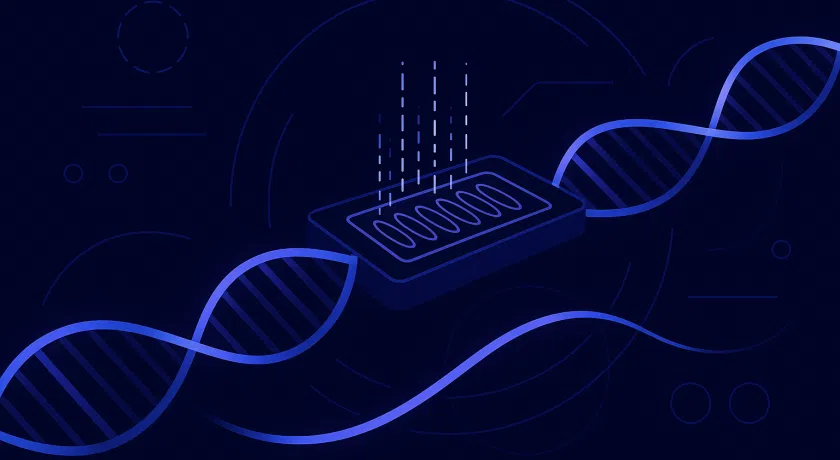
In this blog, we describe how single-cell ATAC-seq (scATAC-seq) works, what its results tell you, and how you can combine scATAC-seq with single-cell RNA sequencing.
In the rapidly evolving landscape of drug discovery, recent developments in single-cell ‘omics technologies have ushered in a new era of precision and efficiency. Single-cell ATAC-seq (scATAC-seq) is the leading new technology for analyzing a cell’s epigenetic traits, specifically the chromatin accessibility profiles of single cells. Hence, you might be interested in adopting the technique for your research.
Before taking a chance with a new technology or approaching technology providers, however, it is helpful to understand how a technology works. Which results can you generate with it? What type of conclusions can you confidently make? And how you can combine technologies to make the most out of your experiments and samples?
In this blog, we do a quick rundown of the steps of the scATAC-seq method and we explain the potential value of scATAC-seq results.
Skip to specific parts in this blog:
- Why study chromatin accessibility?
- The 10x Single Cell ATAC method
- How to interpret scATAC-seq data
- Synergize scATAC-seq with single-cell RNA sequencing
- FAQs
- Information guide
Why study chromatin accessibility?
Cells control their gene expression by an interactive set of regulatory mechanisms such as DNA methylation, histone modification, and transcription factor activity. Chromatin accessibility largely reflects the combined regulatory state of a cell. Hence, the chromatin accessibility profile of a cell serves as a layer of information alongside its transcriptome to describe cell identity.
What’s more, exploring the chromatin accessibility profile enables additional insights into gene regulatory mechanisms and cell differentiation processes that scRNA-seq data might not capture.
Read this blog to learn more about the fundamentals of why researchers use single-cell ATAC-seq.
10x Single Cell ATAC
scATAC-Seq Specifications
- At Single Cell Discoveries, we employ the 10x Genomics Single Cell ATAC solution. It enables high-throughput profiling of the open chromatin landscape at single-cell resolution.
- Single Cell ATAC combines Tn5 tagmentation-based open chromatin identification with our single-cell amplification protocols, Next GEM microfluidic technology, and in-house next-generation sequencing.
- We utilize the most advanced 10x Chromium X Instrument, Illumina NovaSeq X Plus, and/or NovaSeq 2000 sequencing instruments.
scATAC-Seq workflow
Overview:
- Starting point is a mix of isolated nuclei.
- Tn5 is added to drive the fragmentation reaction, where the enzyme enters intact nuclei, cuts into open chromatin regions, and inserts 10x Barcodes to the DNA fragments.
- In the 10x Chromium instrument, single nuclei are partitioned inside droplets. Next, the tagmented DNA fragments undergo single-cell barcoding with the Next GEM technology, after which all fragments from a single cell share a unique barcode.
- Finally, we amplify the fragments by PCR and sequence the libraries. Data analysis maps the sequencing reads and traces each read back to its cell of origin by the barcodes.
Step by step
Step 1: Nuclei isolation
scATAC-seq requires a nucleus suspension as starting material to enable efficient tagmentation. There are several kits and protocols that make it possible to obtain high-quality nuclei suspensions from fresh and cryopreserved cells, fresh tissue, and snap-frozen tissue. Single Cell Discoveries offers nucleus isolation as an included service and we perform it in-house to safeguard sample quality during transport. For complicated isolation, such as nucleus isolation from brain cells, our research & development department is happy to discuss a bespoke solution.
Step 2: Tagmentation
Isolated nuclei undergo tagmentation in bulk by adding Tn5 transposase proteins. In scATAC-seq, tagmentation is the process of adding 10x Genomics barcodes, a kind of “tag”, to all open chromatin. These barcodes are for attaching the DNA fragments onto the 10x primers in the droplets in step 3.
This is performed by the Tn5 transposase, which is at the center of the ATAC-seq assay. Tn5 is a bacterial transposase that can access open chromatin and insert a DNA fragment in the host’s DNA. It essentially works by a cut-and-paste mechanism.
For ATAC-seq, scientists modified Tn5 to become more active and loaded it with a recognizable, 19-base-pair–long “tag”. This step, in combination with the fact that Tn5 integrates essentially randomly in all open chromatin, has made ATAC-seq widely adopted in biomedical research.
Step 3: Single-cell barcoding
The microfluidics-based 10x Chromium X instrument adds a cell-specific barcode to each tagmented DNA fragment. For this, the 10x Genomics technology uses GEMs (Gel bead-in-EMulsion)—water-in-oil emulsion droplets. Each GEM contains a single nucleus encapsulated in barcode-containing gel beads. All tagmented DNA fragments from one cell now share a barcode.
Once the barcodes are added to the sequencing indices, we perform library construction and quality control on the product.
The Illumina NovaSeq X Plus and NextSeq 2000
Step 4: Sequencing
The amplified, barcoded sequencing indices can be sequenced with next-generation sequencing. At Single Cell Discoveries, our sequencing facility houses an Illumina NovaSeq X Plus and NextSeq 2000 for fast, high-throughput sequencing.
Step 5: Data analysis
scATAC-seq data analysis identifies regions of open chromatin across the entire genome. One of the central steps is peak calling. Here, with specialized algorithms such as 10x Genomics CellRanger and MACS2, we identify regions in the genome that are enriched in sequencing reads compared to the background. These peaks correspond to open chromatin regions. Peak calling can be preceded and followed by data filtering steps, which aim to remove low-quality cells, duplicated reads, and peak-related matrices.
By way of the single-cell barcodes, the algorithm can assign peaks to their cell of origin. Then, cell clustering can identify all the cell types present in the sample based on the 10x Single Cell ATAC data. You can assign cell type annotations to each cluster by looking at the chromatin accessibility profile of the clusters in depth, for example by searching for known cell type markers.
It is also possible to perform cell clustering first and perform peak calling on each cluster separately. This can lead to different results and can for example fish out accessibility profiles of rare cells. Finally, our data consultants can follow up this analysis with transcription factor motif enrichment and transcription factor regulatory network or interaction analysis.
Discuss Single Cell ATAC
If you want to perform single-cell ATAC-seq on your sample, you can always connect with our PhD-level scientists. We are happy to discuss your biological question, time line, sample types, and other customizations for your single-cell analysis.
Already have a scATAC–seq library and are looking for a sequencing service? Employ our sequencing facility for high–quality next–generation sequencing with unmatched turnaround times. Exploratory data analysis is included; ATAC consultation or data consultation is always a possibility. Ask any questions in our chat or use a contact form to discuss your project.
Download the 10x Genomics Information Guide
How to interpret
scATAC-seq data
The scATAC-seq workflow produces a chromatin accessibility profile at single-cell resolution, from which you can gather the following insights:
- Peaks in coding regions indicate accessibility for the transcription machinery, so these genes may be expressed or prepared for expression in this cell.
- Peaks in non-coding regions indicate accessibility for regulatory proteins, such as transcription factors. These regions may thus be active regulatory elements.
- A correlation between non-coding regions and coding regions suggests an interplay between regulatory proteins and genes. The non-coding regions may be cis-regulatory elements for the implicated genes, i.e., regions where regulatory proteins bind that affect a neighboring gene’s expression.
- Recurring binding motifs in different non-coding regions can imply which regulatory proteins are active in a cell.
- Cell clustering based on the 10x Single Cell ATAC data generates clusters of cells to which you can assign cell type and subtype names. Selecting the most relevant peaks can help you define clusters. You can compare this to defining clusters by the most variable genes in single-cell RNA-seq. Read more about how we tackle cell type identification in this blog.
- In time-course experiments, you can analyze the changes in regulation and gene expression over time. You can find a good example of such a scATAC-seq experiment in this publication.
- With enough data at single-cell resolution or in time-course experiments, you can identify enriched gene pathways. As a result, you may infer which regulatory networks and functional pathways are active in your tissue or biological process.
Synergize with single-cell RNA sequencing
Importantly, a cell’s chromatin accessibility profile and transcriptome have a mechanistic relationship. Hence, single-cell ATAC and single-cell RNA sequencing data are complementary in the following ways:
Validation
Gene expression and ATAC data can be cross-validated since open chromatin peaks and transcript numbers both indicate expressed genes. Matches between data sets thus provide extra confidence, whereas incongruencies provide doubt for calling a gene expression event.
Gene expression and ATAC data can be directly linked through shared barcodes, cell by cell, in Multiome ATAC. Image Source: 10x Genomics.
Gene regulation
Single-cell RNA sequencing generally provides a higher level of quantitative gene expression. Since each cell only has 2 copies of DNA, chromatin can either open in 0, 1, or max 2 copies. RNA transcripts are more varied; there could be anywhere between 0 and 1000s of transcripts in one cell, so gene expression levels are more reliably quantified.
You can then match this data with scATAC-seq data on non-coding regions that generally indicate active regulation. This enables linking (cis-) regulatory elements with the genes they regulate more accurately. This integrated analysis can uncover regulatory relationships that you might miss with either technique alone.
Contact us if you want to combine scATAC with scRNA-seq.
Frequently asked questions about scATAC-Seq
What types of samples are compatible with scATAC-seq?
scATAC-seq is compatible with samples from any common organism with a reference genome, with cryopreserved cells or snap-frozen tissue. If you are interested in an unusual sample type or, e.g., run into lysis challenges, our research & development unit can help tailor an approach to your needs. Sample requirements for scATAC-seq are the same as the sample requirements for 10x Genomics Single Cell Gene Expression, found here.
How does ATAC-seq compare to other epigenetic methods?
The Tn5 transposase used in single-cell ATAC-seq captures all open chromatin regions. While ChiP-seq and other methods use chromatin regions bound by specific factors. Comparing the two, scATAC-seq provides an unbiased, genome-wide approach. Nevertheless, transcription factors with known binding motifs are identifiable in scATAC-seq data.
What are advantages of scATAC-seq over bulk ATAC-seq?
To read more about the benefits of scATAC-seq, read this blog. In short, scATAC-seq has the following advantages over bulk ATAC-seq:
- Swap averaged signals for single-cell resolution to accurately identify all cell types in a tissue and characterize heterogeneous tissue dynamics.
- Describe cell type or lineage–specific regulatory elements.
- Cell-state identification with higher accuracy is crucial for generating developmental trajectories, cell differentiation, and disease-related changes in cellular states.
- Detect infrequent chromatin accessibility events in small cell populations or during transitional states.
- Higher accuracy in tracking dynamic changes, as with time-course experiments, for instance.
More information about scATAC-Seq
Find more information on single-cell ATAC-seq, 10x Genomics, and our approach in our information guide.
Get the 10x Genomics information guide
Header photograph adapted from Jkwchui (CC BY-SA 3.0)








